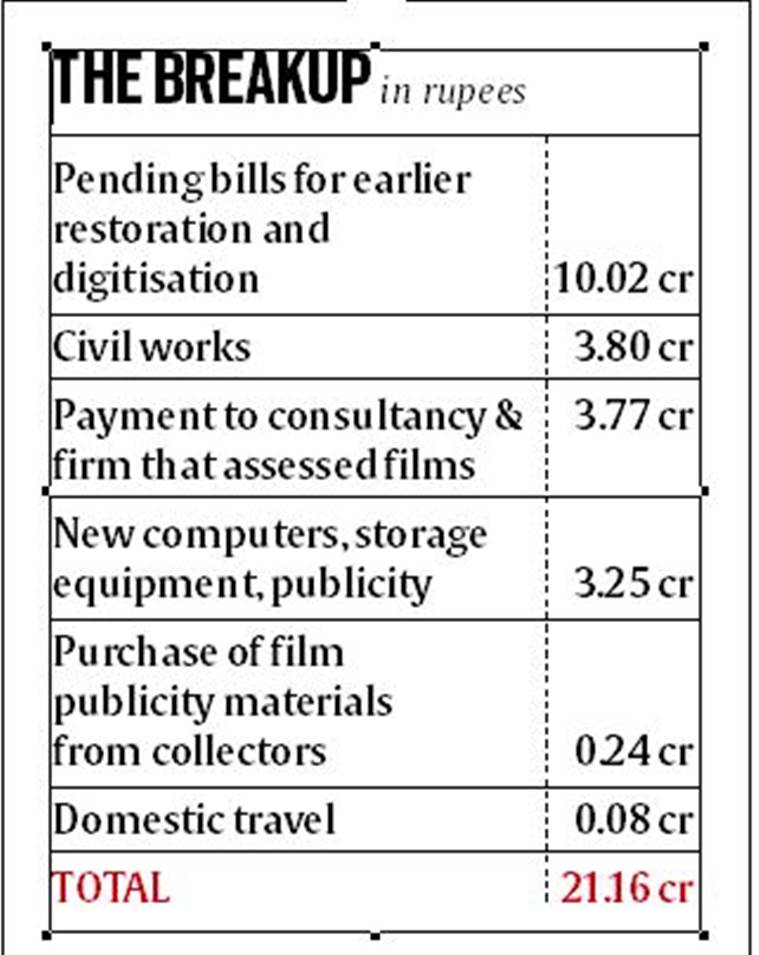EXPRESS RTI: It aims at restoration of 1,050 feature films and 960 shorts; digitisation of 1,050 features and 1,200 shorts, construction of vaults of international standards, and training programmes.

ATIKH RASHID
When the National Film Heritage Mission (NFHM) was rolled out in November 2014 with the Union Cabinet approving Rs 597.41 crore, the National Film Archive of India (NFAI) in Pune was selected as the implementing agency. The scheme’s objective is preservation and restoration of India’s celluloid film heritage, the work to be undertaken from 2014-15 to 2020-21. It aims at restoration of 1,050 feature films and 960 shorts; digitisation of 1,050 features and 1,200 shorts, construction of vaults of international standards, and training programmes.
Of the total allocation, Rs 291 crore is to be spent during the 12th Plan and Rs 306.41 crore during 13th. In the last three years, NFAI has received Rs 21.16 crore under NFHM. Half these funds went into settling an old liability that NFAI owed to a subsidiary of Reliance Anil Dhirubhai Ambani Group, according to accounts accessed by The Indian Express under the Right to Information Act. The firm had been contracted for digitisation and restoration of films before NFHM was rolled out.
NFAI paid Reliance Media Works Limited Rs 10 crore in December 2014 to clear the “outstanding liability” after it received an approval for this from the I&B Ministry. In April 2015, Rs 2 lakh was additionally paid; this “cleared the liability totally”.
NFAI officials said that under the earlier project for digitisation and restoration, which was executed during the 11th Plan (2007-12), 566 films were digitised, including 329 that were restored. Bills for this work, submitted by Reliance Media Works between March 2011 and March 2012, and accessed by The Indian Express, were for Rs 38.71 crore.
“[The Rs 10.02 crore] was an outstanding amount, which could not be paid due to budget constraints during the 11th Five Year Plan,” said Prakash Magdum, NFAI director. “In fact, this was a kind of pilot project of digitisation in which some of the finest films from India were digitised, thereby making them accessible to cinema lovers. The objectives of NFHM were envisaged based on learnings from this project.”
NFAI spent Rs 3.80 crore on civil works, which included renovation and refurbishing of NFAI auditorium, installation of three new DCP projectors, modification of the director’s office, electrical works, renovation of toilets, construction of temporary sheds and parking area, thermal insulation of service blocks, and new workstations for staff. And Rs 3.25 crore was spent on purchase of new computers, storage equipment as well as on publicity including social media management.

Another Rs 3.77 crore was spent on payment to KPMG India, which won the contract for the consultancy firm for NFHM, and Prasad Labs that bagged the contract for condition assessment of the films with NFAI.
Besides, Rs 24 lakh and Rs 8 lakh were spent on buying film publicity material from hobbyists and domestic travel respectively. NFAI pays collectors of non-film material such as posters, stills, song booklets, press clippings at photos at various rates, ranging from Rs 100 per item belonging to contemporary times (since 1991) to Rs 1,000 per item belonging to the silent era.
On spending NFHM funds on civil works at NFAI, Makhdum said, “In order to fulfil objectives of NFHM, there is necessity for creating infrastructure environment which can be done in the government through major and minor works, which has changed the overall organisation setup and helped bringing it to modern, technology, equipped and state of art archive setup. Also enabling it to come closer to people at large.”


